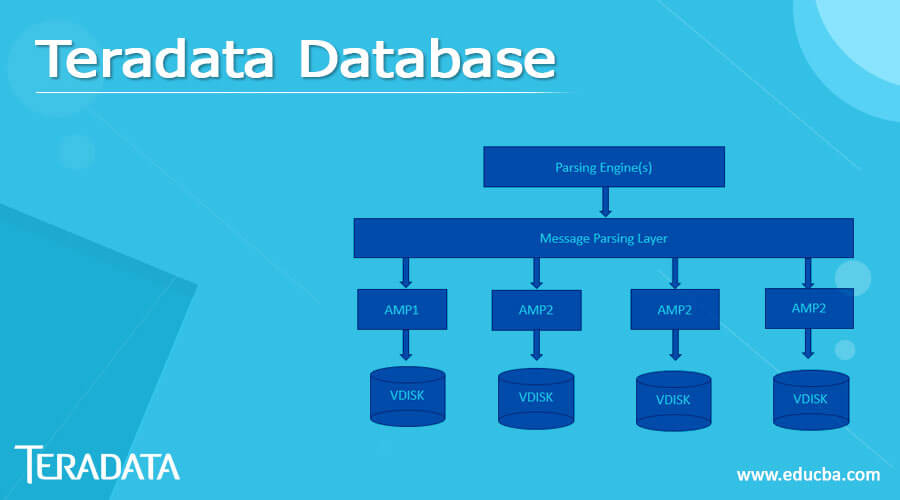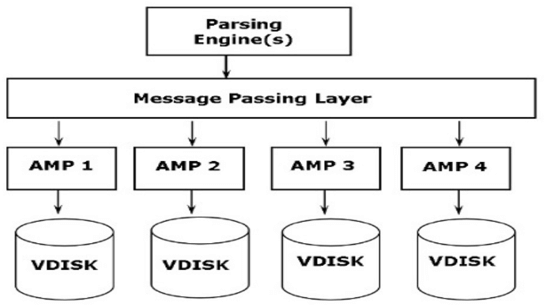Updated July 6, 2023

Definition of Teradata Database
Teradata database is the most popular database in relational management systems, this database is mainly suitable for large-scale data and for data warehousing applications, it is achieved by using the parallelism concept. Basically, it is developed by the company name teradata. As we can say that teradata is used in many industries like healthcare, manufacturing, and transport for optimization of their process by using this database.
What is Teradata Database?
- We can run on Linux, windows, and UNIX operating systems. So we can say that it is not platform oriented.
- It supports the data application which contains huge data. This database consists of the different types of options for deployment.
- This database is supporting various users from multiple platforms. This application consists of parallel architecture.
- We can use for generating big reports such as trends of the business. Basically, those reports are useful for future prediction, which was used to improve the decision-making of an organization.
- It contains the intelligence tools of operations that enhance operational or front-line decision-making.
History of Teradata Database
Below is the history as follows.
- 1979 – In this year teradata database is incorporated.
- 1984 – In this year’s release comes of first database computer as DBC/1012.
- 1986 – In this year the magazine fortune named the teradata database as the year of the product.
- 1999 – In this year it will become the largest database in the world.
- 2002 – In this year teradata will release with primary index partition and compression.
- 2006 – In this year launched teradata for the solution of database management.
- 2008 – In this year teradata 13.0 will be released with data warehousing which was active.
- 2012 – In this year new version 14.0 is introduced.
- 2014 – In this year new version 15.0 is introduced.
- 2016 – In this year new version 16.0 is introduced.
- This database is supporting the intelligence of strategy which provided queries, intelligence tools, and utilities which was used for decision making.
Why use teradata database?
We can use it for the following purpose which is to separate from another RDBMS system.
- It will offer a service which was fully suited and is solely focused on data warehousing.
- It is built on an architecture that was open. So whenever we add any faster device into the system, this device is incorporated with this architecture.
- The big advantage is that it will support the huge data which was 50+ petabytes.
- It contains a single view of large teradata systems by using the workstation.
- This database is well compatible with the BI tool which was used in a wide range for fetching the data.
- We can manage this database by using a single point, so it is very easy for DBA to manage this type of database.
- It contains good management of workload, also it contains the high-performance retrieval of data and queries which was diverse.
- This database is providing a solution to allow the same data on multiple platforms of deployment.
- It is very useful and important to handle large database application, which contains a huge amount of data.
How does it work?
- Index is the physical mechanism that was used to access and store the data in a table.
- As we know in other database management system indexes like a book, it will speed up the retrieval of data.
- Teradata database will distribute the data as per the primary index which was created at the time of table creation.
- When we run a query to insert the records the parsing engine of the database server will send the records to BYNET.
- The teradata database is hashed by using the algorithm of hash by using a primary index. In teradata database hash algorithm is used, it is producing hash bucket.
- The BYNET will send the records to the respective AMP based on values of hash which was stored in the associated disks.
- Basically, it will use the hash values to store data from various AMP. For viewing the data distribution of the table we need to use hash functions.
- Hash function is used to find the data from the actual distribution column which was primary indexed.
Teradata Database Features
Terada database consists of multiple features.
- Unlimited parallelism – Teradata database is based on the parallel processing of data architecture. The MPP architecture will divide the workload into the entire system.
- Shared nothing architechture – Teradata database is also called an architechture of shared nothing
- Linear scalability – As we know that teradata database is highly scalable. We can scale up to 2048 nodes.
- Connectivity – Terada database is attached to the mainframe systems or the network attached systems.
- Mature optimizer – We can say that optimizer is the only single mature optimizer available. We can refine the same in every release.
- SQL – Teradata database supports SQL which was industry standard with the data stored in the table.
- Robust utilities – This database is provided utilities like importing and exporting the data from database tables.
- Automatic distribution – The teradata database automatically distributes the data on a disk without any manual intervention.
Architecture
It consists mainly of the below components.
- It consists of the architecture of parallel processing.
- Parsing engine
- BYNET
- AMP (Access module processors)
- Disk
The below figure shows the architecture and components of database architecture.
- Parsing engine – This component is used to parse the query and make an execution plan. This will manage the session for users. Also, it will manage and sends a request to users.
- AMP – This component is used to store the records on a disk. AMP will do many activities on the disk.
- BYNET – This component will act as a channel between the AMP and PE. There are two different types of BYNET i.e. Bynet1 and Bynet0.
- Disk – Teradata database is offering virtual disks for amps. The storage area of each AMP is called a virtual disk.
Conclusion
Teradata database system is built on an architecture that was open. Teradata database is the most popular database in relational management systems. It supports the data application which contains huge data. This database consists of the different types of options for deployment.
Recommended Articles
This is a guide to Teradata Database. Here we discuss the Definition, What is Teradata Database, Why to use it and How does it work along with its features. You may also have a look at the following articles to learn more –

